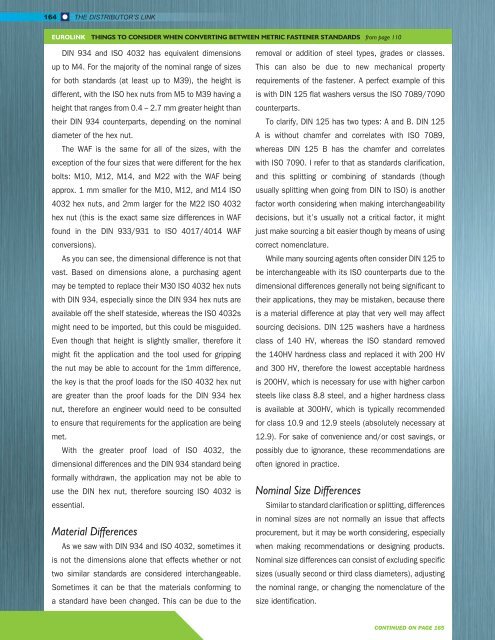WINTER 2021
Distributor's Link Magazine Fall 2020 / Vol 44 No 1
Distributor's Link Magazine Fall 2020 / Vol 44 No 1
Create successful ePaper yourself
Turn your PDF publications into a flip-book with our unique Google optimized e-Paper software.
164<br />
THE DISTRIBUTOR’S LINK<br />
EUROLINK THINGS TO CONSIDER WHEN CONVERTING BETWEEN METRIC FASTENER STANDARDS from page 110<br />
DIN 934 and ISO 4032 has equivalent dimensions<br />
up to M4. For the majority of the nominal range of sizes<br />
for both standards (at least up to M39), the height is<br />
different, with the ISO hex nuts from M5 to M39 having a<br />
height that ranges from 0.4 – 2.7 mm greater height than<br />
their DIN 934 counterparts, depending on the nominal<br />
diameter of the hex nut.<br />
The WAF is the same for all of the sizes, with the<br />
exception of the four sizes that were different for the hex<br />
bolts: M10, M12, M14, and M22 with the WAF being<br />
approx. 1 mm smaller for the M10, M12, and M14 ISO<br />
4032 hex nuts, and 2mm larger for the M22 ISO 4032<br />
hex nut (this is the exact same size differences in WAF<br />
found in the DIN 933/931 to ISO 4017/4014 WAF<br />
conversions).<br />
As you can see, the dimensional difference is not that<br />
vast. Based on dimensions alone, a purchasing agent<br />
may be tempted to replace their M30 ISO 4032 hex nuts<br />
with DIN 934, especially since the DIN 934 hex nuts are<br />
available off the shelf stateside, whereas the ISO 4032s<br />
might need to be imported, but this could be misguided.<br />
Even though that height is slightly smaller, therefore it<br />
might fit the application and the tool used for gripping<br />
the nut may be able to account for the 1mm difference,<br />
the key is that the proof loads for the ISO 4032 hex nut<br />
are greater than the proof loads for the DIN 934 hex<br />
nut, therefore an engineer would need to be consulted<br />
to ensure that requirements for the application are being<br />
met.<br />
With the greater proof load of ISO 4032, the<br />
dimensional differences and the DIN 934 standard being<br />
formally withdrawn, the application may not be able to<br />
use the DIN hex nut, therefore sourcing ISO 4032 is<br />
essential.<br />
Material Differences<br />
As we saw with DIN 934 and ISO 4032, sometimes it<br />
is not the dimensions alone that effects whether or not<br />
two similar standards are considered interchangeable.<br />
Sometimes it can be that the materials conforming to<br />
a standard have been changed. This can be due to the<br />
removal or addition of steel types, grades or classes.<br />
This can also be due to new mechanical property<br />
requirements of the fastener. A perfect example of this<br />
is with DIN 125 flat washers versus the ISO 7089/7090<br />
counterparts.<br />
To clarify, DIN 125 has two types: A and B. DIN 125<br />
A is without chamfer and correlates with ISO 7089,<br />
whereas DIN 125 B has the chamfer and correlates<br />
with ISO 7090. I refer to that as standards clarification,<br />
and this splitting or combining of standards (though<br />
usually splitting when going from DIN to ISO) is another<br />
factor worth considering when making interchangeability<br />
decisions, but it’s usually not a critical factor, it might<br />
just make sourcing a bit easier though by means of using<br />
correct nomenclature.<br />
While many sourcing agents often consider DIN 125 to<br />
be interchangeable with its ISO counterparts due to the<br />
dimensional differences generally not being significant to<br />
their applications, they may be mistaken, because there<br />
is a material difference at play that very well may affect<br />
sourcing decisions. DIN 125 washers have a hardness<br />
class of 140 HV, whereas the ISO standard removed<br />
the 140HV hardness class and replaced it with 200 HV<br />
and 300 HV, therefore the lowest acceptable hardness<br />
is 200HV, which is necessary for use with higher carbon<br />
steels like class 8.8 steel, and a higher hardness class<br />
is available at 300HV, which is typically recommended<br />
for class 10.9 and 12.9 steels (absolutely necessary at<br />
12.9). For sake of convenience and/or cost savings, or<br />
possibly due to ignorance, these recommendations are<br />
often ignored in practice.<br />
Nominal Size Differences<br />
Similar to standard clarification or splitting, differences<br />
in nominal sizes are not normally an issue that affects<br />
procurement, but it may be worth considering, especially<br />
when making recommendations or designing products.<br />
Nominal size differences can consist of excluding specific<br />
sizes (usually second or third class diameters), adjusting<br />
the nominal range, or changing the nomenclature of the<br />
size identification.<br />
CONTINUED ON PAGE 165
















